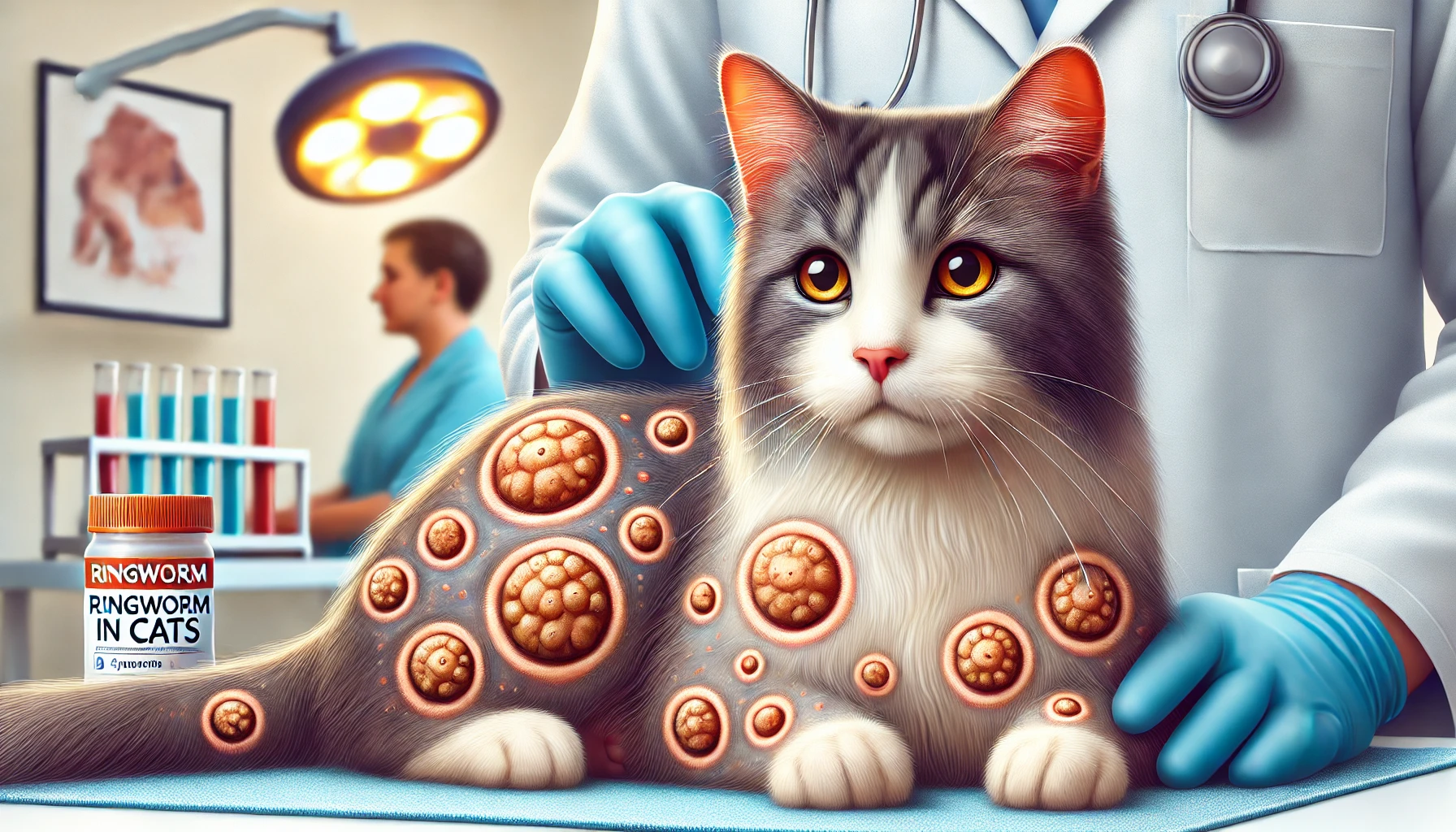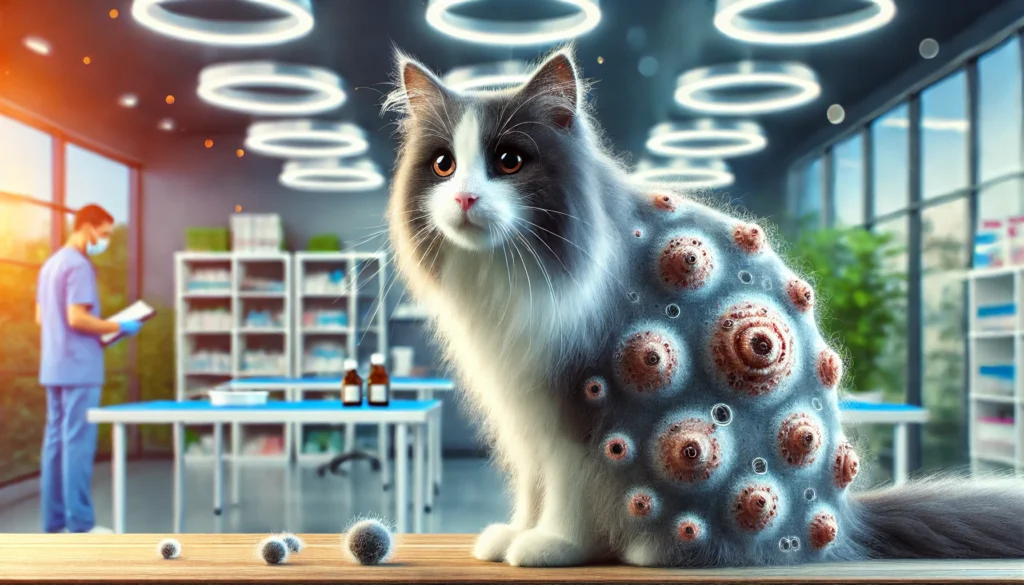Ringworm in Cats: An Insightful Guide to Symptoms, Treatment, and Prevention

Introduction
Ringworm is a common concern among cat owners, raising questions from “What does ringworm look like?” to “How do you treat ringworm in cats?” This article provides a detailed look at ringworm in cats, covering everything from early signs to effective treatment options.
Understanding Ringworm
Ringworm, contrary to its name, is not caused by a worm but by a fungal infection affecting the skin, hair, and nails. It’s particularly prevalent in cats, where it causes patchy hair loss and scaly skin. The fungi responsible for ringworm include Microsporum canis, Microsporum gypseum, and Trichophyton mentagrophytes, with Microsporum canis being the most common culprit.

Symptoms of Ringworm in Cats
Ringworm in cats can manifest through various signs, including:
- Circular patches of hair loss, often on the head, ears, and paws
- Scaly or crusty skin beneath the fur
- Reddened skin, sometimes accompanied by pimples
- Nail and claw abnormalities in severe cases
These symptoms often cause discomfort, leading cats to scratch and further irritate the area.
How Do Cats Get Ringworm?
Transmission of ringworm can occur through direct contact with an infected animal or through contact with contaminated objects like bedding, brushes, or even surfaces where the fungus may reside. Kittens, elderly cats, or those with compromised immune systems are particularly susceptible.
Diagnosing Ringworm in Cats
Diagnosis typically begins with a visual examination, followed by more definitive methods such as:
- Wood’s Lamp Examination: This UV light can detect fluorescence associated with some strains of ringworm.
- Fungal Culture: The gold standard for diagnosing ringworm, this test involves culturing samples on a special medium to identify the specific fungus.
- Microscopic Examination of Hair: This can reveal spores that cling to the hair shafts.
Treatment Options for Ringworm in Cats
Treatment for ringworm in cats should be comprehensive, involving:
- Topical Treatments: Medicated shampoos and ointments can help reduce fungal spores.
- Oral Antifungal Medications: These are necessary for severe cases and can include drugs like itraconazole or terbinafine.
- Environmental Cleaning: Regular cleaning with bleach or other fungicidal agents can help prevent the spread of the fungus.
Preventing re-infection is crucial, necessitating thorough cleaning of the home and regular treatment applications as prescribed.
Preventing Ringworm in Cats
Prevention strategies include:
- Regular Veterinary Check-ups: Early detection and treatment of ringworm can prevent wider outbreaks.
- Environmental Hygiene: Regular cleaning and disinfecting of your cat’s living area can minimize fungal spores.
- Isolation of Infected Pets: Keeping infected animals separate from other pets can reduce transmission.
Do you know?
Avocados boast a rich content of vitamins A, B6, C, E, and K, and are loaded with fiber and healthy monounsaturated fats.
Conclusion of Ringworm in Cats
Ringworm in cats is a treatable condition, but it requires a diligent approach to both medical treatment and environmental management. Understanding the signs and stages of ringworm can help cat owners seek timely treatment and prevent its spread. Always consult a veterinarian if you suspect your cat has ringworm or if you’re seeking advice on treatment and preventive care strategies.
What does ringworm look like?
Ringworm typically appears as a red, circular rash on the skin, often accompanied by scaly, itchy, or raised edges. It might look like a ring, which is where the infection gets its name.
How do you get ringworm?
Ringworm is contracted through direct contact with an infected person, animal, or object. The fungus thrives in warm, moist environments and can be spread by touching contaminated items like towels, clothing, or surfaces.
Is ringworm contagious?
Yes, ringworm is highly contagious and can be transmitted between humans, animals, and even through contact with objects or soil containing the fungus.
How to get rid of ringworm?
Treatment typically involves antifungal medications applied topically as creams or ointments, or taken orally if the infection is severe or widespread. Keeping the infected area clean and dry also helps curb the spread.
Ringworm from cats to humans?
Humans can contract ringworm from cats through direct contact with infected skin or fur. The risk increases in environments with multiple cats or poor sanitation.
Ringworm treatment for humans?
For humans, ringworm treatment usually involves topical antifungal creams for mild cases. More severe cases might require prescription-strength creams or oral antifungal medications.
How do you get rid of ringworm in a cat?
Treating ringworm in cats generally involves antifungal shampoos, ointments, or oral medications. Environmental cleaning to remove spores is also crucial to prevent reinfection.
How can I tell if my cat has ringworm?
Look for signs like circular patches of hair loss, scaly or red skin, and excessive scratching. A veterinarian can confirm the diagnosis through tests like a fungal culture or using a Wood’s lamp.
Can humans get ringworm from cats?
Yes, humans can catch ringworm from cats. The fungus can transfer from the cat’s fur or skin to humans through direct contact.
Is it OK to touch a cat with ringworm?
It’s best to avoid touching a cat with ringworm until the infection is treated and cleared. If contact is necessary, wear gloves and wash your hands thoroughly afterwards to prevent the spread of the fungus.






